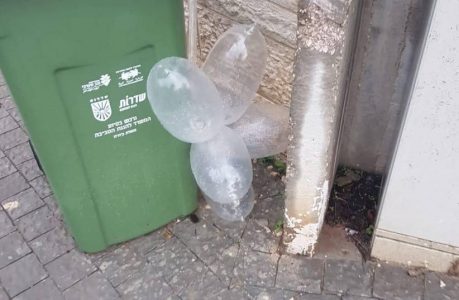
How condoms became a Palestinian weapon against Israel
Two years after Palestinians first started launching flaming kites and other aerial explosive devices like condoms and balloons into southern Israel, the phenomenon has yet to fade. It started with kites with burning rags or embers attached to them. Three months later, booby-trapped balloons and condoms began to be carried east towards southern Israel by winds coming off of the Mediterranean.
While the use of kites which is a popular Palestinian pastime seems to have disappeared, dozens of balloons and condoms with explosive devices attached to them continue to land in schoolyards, agricultural fields and busy roads.
Israel’s defense establishment does not use the word condoms, it’s not the most “politically correct” word, and has been referring to them as balloons.
Though condoms or balloons bearing messages of “Happy Birthday” or “I ❤️ You” flying through the air may sound silly, the hard truth is that these simple devices have wreaked havoc in the south, burning thousands of acres of land and costing millions of shekels in damage.
Not to mention the real fear of parents who are constantly concerned about their child possibly picking up these explosive toys and inflated prophylactics. On Wednesday, children in a kindergarten near Kiryat Gat were forced to run for shelter after their teacher noticed a batch of suspicious balloons drifting nearby.
Imagine had that batch of colorful balloons landed and exploded in the schoolyard full of children.
At the beginning the aerial improvised explosive devices fell close to where they had been launched, but recently Gazans have been tying together the condoms and balloons for added buoyancy and successfully increasing their range.
Two weeks ago several balloons with a rocket propelled grenade attached were discovered close to a gas station by security staff at the Midreshet Ben-Gurion educational center near Sde Boker, some 70 kilometers from the blockaded coastal enclave.
“We confirm that a suspicious object landed in an open area south of the Negev region, bomb disposal experts are at the scene. No injuries or damage caused. Bomb disposal experts continue to patrol the south and respond to any suspicious objects or balloons that have fallen,” Mickey Rosenfeld, Spokesperson for the Israel Police told The Jerusalem Post at the time.
No damage or injuries, but again, imagine had that rocket propelled grenade gone off. Condoms in Gaza have generally been supplied by either local Palestinian organizations or through international programs and the helium used to fill them up-as well as for various medical reasons such as for MRI machines-enters the Strip with Israel’s approval.
When first faced with the explosive condom threat, Israel’s Coordinator of Government Activities in the Territories (COGAT) limited the the entrance of condoms, balloons and helium into the Hamas-run coastal enclave. The ban remains in place.
A spokesperson for COGAT told The Jerusalem Post that the items are considered as dual-use and goods such as these require permits to be allowed into the Gaza Strip. Since they are no longer allowed to cross from Israel, it is believed that they are imported from Gaza through the Rafiah crossing.
But two years later the south continues to be plagued by explosive condoms.
The balloons and condoms have proven difficult to shoot down and has confounded politicians and military officials alike. Israel’s famed Iron Dome missile defense system is also useless against such weapons.
Israel has fought at least three full-scale wars with Hamas and other terror groups in the coastal enclave but both the government and military understand that it’s a hard sell to launch another military campaign because of condoms.
Instead, the military has been responding to these explosives by retaliatory strikes against Hamas targets and by reducing the allowed fishing zone off of the Gazan coast. But other than that, there does not seem to be a military solution to this burning problem.
Source: JP





